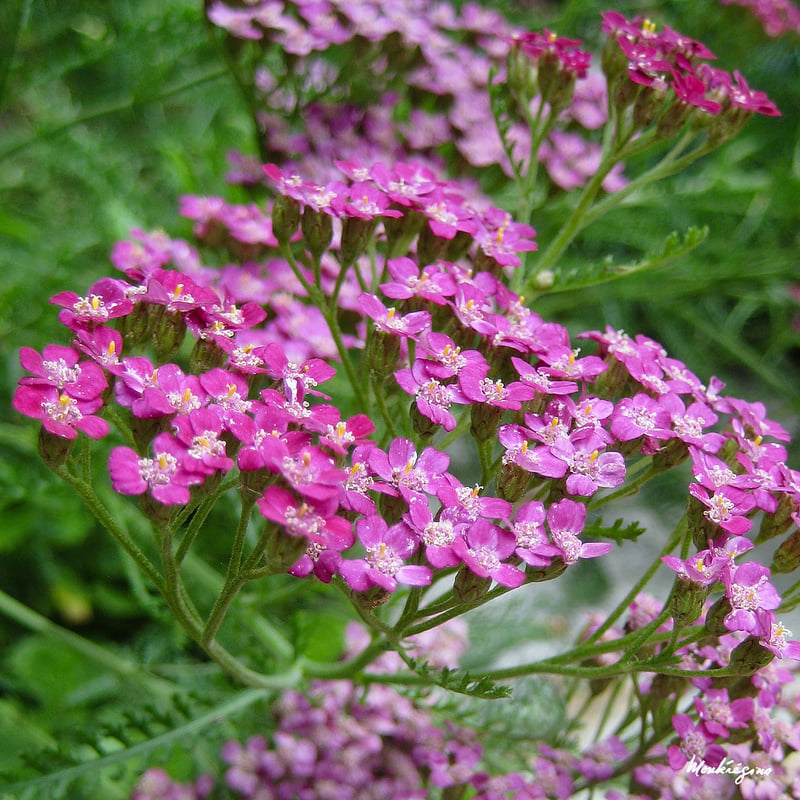
Yarrow (Achillea millefolium)
One of the all-around terrific herbs to support personal strength, creativity and expression is Yarrow (Achillea millefolium). Yes, I know, it’s hard to imagine that Summer is coming to a close as the days are obviously shorter and Autumn schedules start to kick in. Where I live, community colleges have started, and folks are selecting crafts groups, music lessons, yoga classes, and other personal development opportunities for the darker time of year. It is a time for self-reflection and self-expression.
As we open up to “creative mode”, new learning has a tendency to make us wonder what others will think of us.
Will we do well? Will we be accepted? Will we really enjoy what we are doing and “fit in”? Yarrow has a tradition of supporting people who are sensitive to personal expression and criticism. Yarrow gives us the ability to remain vulnerable and at the same time open to being our true selves. We open up instead of shut down. We realize our inner gifts and do something with them. This is the harvest time of year and saying “thanks” for our gifts also means we use them wisely. Yarrow can assist this exciting process.
Background Information:
Family Name: Asteraceae
Other Common Names: milfoil, woundwort, “cure all”, “nose bleed”, “carpenter’s weed”, Knight’s milfoil, old man’s pepper, noble Yarrow, staunchgrass
General Characteristics: Yarrow (Achillea millefolium) is a perennial herb; its compound leaves are bright green and feathery (“millefolium” means “thousand leafed”); the heads are white, yellow or pink flat-topped clusters; Yarrow grows in Europe and Western Asia

Yarrow. Photo credit: monteregina / Foter / Creative Commons Attribution-NonCommercial-ShareAlike 2.0 Generic (CC BY-NC-SA 2.0)
Active Constituents: rich in volatile oils such as camphor, chamazulene, linalool, pinene, thujone, azulene, proazulene, betacarotene; also pyrrolidine alkaloids, flavonoids, Vitamin C and Vitamin E
Therapeutic Actions: antiseptic, anti-inflammatory, astringent, styptic, diaphoretic, antispasmodic, bitters (aids in digestion) stimulating (delayed menses) and sedative (relaxes cramping), amphoteric (goes where it is needed in the body)
CAUTIONS: Yarrow is generally considered safe and nontoxic; *because of stimulating affects on uterine muscles AVOID during pregnancy; Yarrow (an Asteraceae) can cause an allergic reaction (itchy eyes and/or rash) ~ discontinue use if this occurs.
Folklore: The I Ching was originally cast using stalks of Yarrow instead of coins; In some countries Yarrow / Yarroway was used to foretell a person’s romantic future; the flower essence gives psychic protection against loss of energies because (it is conjectured) that Yarrow grows along the Earth’s ley lines which reinforces a person’s energy field.
Magickal: Use in any work, spell work, ritual/s that involve maintaining personal energy, self-expression, protection against negative criticism, promote creativity and creative endeavors, and express gratitude for personal creative / expressive gifts.
Recipe (courtesy of Judith Berger, Herbal Rituals, pg. 190):
“Yarrow Flower Essence”
On a sunny, dry morning
Use spring or distilled water
Fresh Yarrow flowers, with (part of) stems
Brandy or similar preservative
A glass bowl
Amber or cobalt bottles
Labels
Dropper bottles

Yarrow with White Flower. Photo credit: Dendroica cerulea / Foter / Creative Commons Attribution 2.0 Generic (CC BY 2.0)
Sit quietly with the flowers relaxing the mind and body. Fill the glass bowl with the spring or distilled water. Float the flowers on the surface of the water taking extra care to handle by the stems and not the flowers. Cover the surface of the water with flowers. Place the bowl in bright sunlight for three hours. If the blossoms start to fade before three hours, then start the removal process before three hours. Remove the flowers by hand, being careful to touch the water as little as possible. Fill the amber bottles half way with the water. Add an equal amount of brandy (or similar) as a preservative. This bottle is the “mother essence”. From this bottle, put two – three drops of essence water into one-ounce dropper bottles of spring / distilled water and 5 to 6 drops of brandy (or similar) as a preservative. Lightly tap the dropper bottle to release the essence water energies before using.
OK! So “go for it” ~ that new writing project, music or art class, public speaking opportunity, cooking class – and any other creative endeavors. You do not have to do this alone. Let Yarrow help you express yourself with confidence and joy.

Nothing but pink Yarrow! Photo credit: gailhampshire / Foter / Creative Commons Attribution 2.0 Generic (CC BY 2.0)
Blessed Be!
*** The above information is for educational purposes only. The information is not meant to replace the consultation of a licensed health-care professional. This author and CoG-OCLC are not to be held responsible for the use or misuse of the information contained within this blog.
References:
Essences of Nature by Mary Ann Antenucci, Light Technology Publishers (2013) Pgs. 23 – 24.
Herbal Rituals by Judith Berger, St. Martin’s Press (1998) Pgs. 184 – 192.
Medicinal Herbals: A Beginners Guide by Rosemary Gladstar, Storey Publishing (2012) Pgs. 212 – 216.
Herb Wisdom. Retrieved from www.herbwisdom.com/herb-yarrow.html, Hallnet Ltd. (2014).
Medicinal Plants of the World by Ben-Erik van Wyck and Michael Wink, Timber Press, Inc. (2012) Pgs. 30 , 395
Yarrow – purple flower photo credit. Photo credit: monteregina / Foter / Creative Commons Attribution-NonCommercial-ShareAlike 2.0 Generic (CC BY-NC-SA 2.0)
Yarrow – white flower. Photo credit: <a href=”https://www.flickr.com/photos/dendroica/14915049916/”>Dendroica cerulea</a> / <a href=”http://foter.com”>Foter</a> / <a href=”http://creativecommons.org/licenses/by/2.0/”>Creative Commons Attribution 2.0 Generic (CC BY 2.0)</a>
Nothing but Yarrow. Photo credit: <a href=”https://www.flickr.com/photos/gails_pictures/10594741885/”>gailhampshire</a> / <a href=”http://foter.com”>Foter</a> / <a href=”http://creativecommons.org/licenses/by/2.0/”>Creative Commons Attribution 2.0 Generic (CC BY 2.0)</a>
